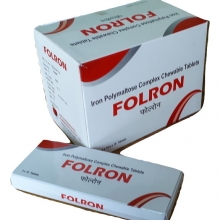Home / Categories / FOLRON TAB

FOLRON TAB
(10X3X10)
IRON III POLYMALTOSE-100MG
DIETARY SUPPLEMENTS-IRON, FOLIC ACID AND RELATED COMPOUNDS(HAEMATINICS)
APPLE INTERNATIONAL PHARMACEUTICALS P. LTD.
Product Details
| (iron DEX-tran) |
DexFerrum, InFeD,  Infufer Infufer |
| Class: Iron product |
 Action Replenishes Hgb and depleted iron stores.
Action Replenishes Hgb and depleted iron stores.
 Indications Treatment of iron deficiency anemia when oral administration of iron is unsatisfactory or impossible. Unlabeled use(s): Use with epoetin to ensure hematological response to epoetin.
Indications Treatment of iron deficiency anemia when oral administration of iron is unsatisfactory or impossible. Unlabeled use(s): Use with epoetin to ensure hematological response to epoetin.
 Contraindications Anemia not associated with iron deficiency.
Contraindications Anemia not associated with iron deficiency.
Prior to the first IV or IM iron dextran injection, give a 0.5 ml test dose by the same route, respectively. Anaphylactic reactions occurring following iron dextran injection are usually evident within a few minutes; however, at least 1 hr should elapse before the remainder of the therapeutic dose is given.
Iron Deficiency Anemia
ADULTS & CHILDREN: IM/IV with dose based on formula to determine amount of iron required to restore hemoglobin to normal levels (max 2 ml/day undiluted iron dextran):
£ 30 lb.
Iron Replacement for Blood Loss
ADULTS & CHILDREN: TEST DOSE: IM/IV with dose based on formula that 1 ml of normocytic, normochromic RBC cells contains 1 mg of elemental iron (maximum 2 ml/day undiluted iron dextran):
Mg iron — blood loss (ml) × Hct
Each day's dose should not exceed 0.5 ml (25 mg iron) for infants < 10 lb or 1 ml (50 mg iron) for children < 20 lb, or 2 ml (100 mg iron) for other patients.
Chloramphenicol: May increase serum iron concentrations. INCOMPATIBILITIES: Do not mix with other medications or add to parenteral nutrition solutions for IV infusions.
 Lab Test Interferences Serum bilirubin: Drug may cause falsely elevated values. Serum calcium: Drug may cause falsely decreased values.
Lab Test Interferences Serum bilirubin: Drug may cause falsely elevated values. Serum calcium: Drug may cause falsely decreased values.
CV: Hypotension; peripheral vascular flushing (IV). CNS: Headache; dizziness; malaise; transitory paresthesias. DERM: Brown skin discoloration at IM injection site. GI: Nausea. HEMA: Leukocytosis. OTHER: Hypersensitivity (eg, fatal anaphylaxis, shortness of breath, urticaria, itching, arthralgia, myalgia, fever); pain and inflammation at injection site; sterile abscesses (IM); phlebitis at IV injection site; reactivation of arthritis in patients with inactive rheumatoid arthritis; backache; shivering. Delayed reactions may occur 1 to 2 days after administration.
Pregnancy: Safety not established. Based on animal studies, avoid if possible. Lactation: Undetermined. Children: Not recommended in children < 4 mo. Allergies/Asthma: Use drug with caution in patients with history of significant allergies/asthma. Arthritis: Patients with iron deficiency anemia and rheumatoid arthritis may have acute exacerbation of joint pain and swelling after IV administration. Hepatic impairment: Use drug with extreme caution in severe hepatic impairment. Hypersensitivity: Hypersensitivity, including anaphylaxis, may occur. Have epinephrine immediately available.
| PATIENT CARE CONSIDERATIONS |
|
- Oral iron preparations should be discontinued before parenteral administration.
- Inject IM via Z-track technique into upper outer quadrant of buttock; never inject iron dextran into arm or other exposed areas. Use 2- to 3-inch 19- or 20-gauge needle.
- If patient is standing, weight should be placed on leg opposite injection site. If in bed, patient should be in lateral position with injection site uppermost.
- Change needles between withdrawal from container and injection to minimize staining of SC tissues. Stains usually are permanent.
- For IV administration, inject slowly at £ 1 ml/min.
- Store at room temperature.
- Obtain patient history, including drug history and any known allergies.
- Assess patient's nutritional status and dietary history to determine possible causes of anemia.
- Monitor Hgb, Hct, and reticulocyte values; transferrin, ferritin, total ironbinding capacity; and plasma iron concentrations periodically during therapy.
- Assess patient for signs of anaphylaxis (eg, rash, pruritus, laryngeal edema, wheezing).
- Monitor BP and heart rate frequently during IV administration.
- Assess patient for symptoms of GI distress and constipation regularly throughout therapy.
- Provide diet high in iron (eg, organ meats; leafy, green vegetables; dried beans and peas; dried fruit; cereals).
- If constipation occurs, obtain order for laxative. Increase fiber and give additional fluids.
|
||||
- Teach family and patient the name, dose, action, and side effects of iron.
- Advise patient to take additional fluids to prevent constipation.
- Teach patient that certain foods, such as coffee, tea, eggs, and milk, interact with iron.
- Teach patient and family the daily iron requirements (children 6 mo to 10 yr: 10 mg; adolescents 11 to 18 yr, male: 12 mg; adolescents 11 to 18 yr, female: 15 mg; adult women, pregnant: 30 mg; adult women, nonpregnant: 15 mg; adult men: 10 mg).
Books@Ovid
Copyright © 2003 Facts and Comparisons
David S. Tatro
A to Z Drug Facts
Substitutes
Substitutes not found for FOLRON TAB
 Route/Dosage
Route/Dosage Interactions
Interactions Adverse Reactions
Adverse Reactions Precautions
Precautions Administration/Storage
Administration/Storage Assessment/Interventions
Assessment/Interventions Patient/Family Education
Patient/Family Education